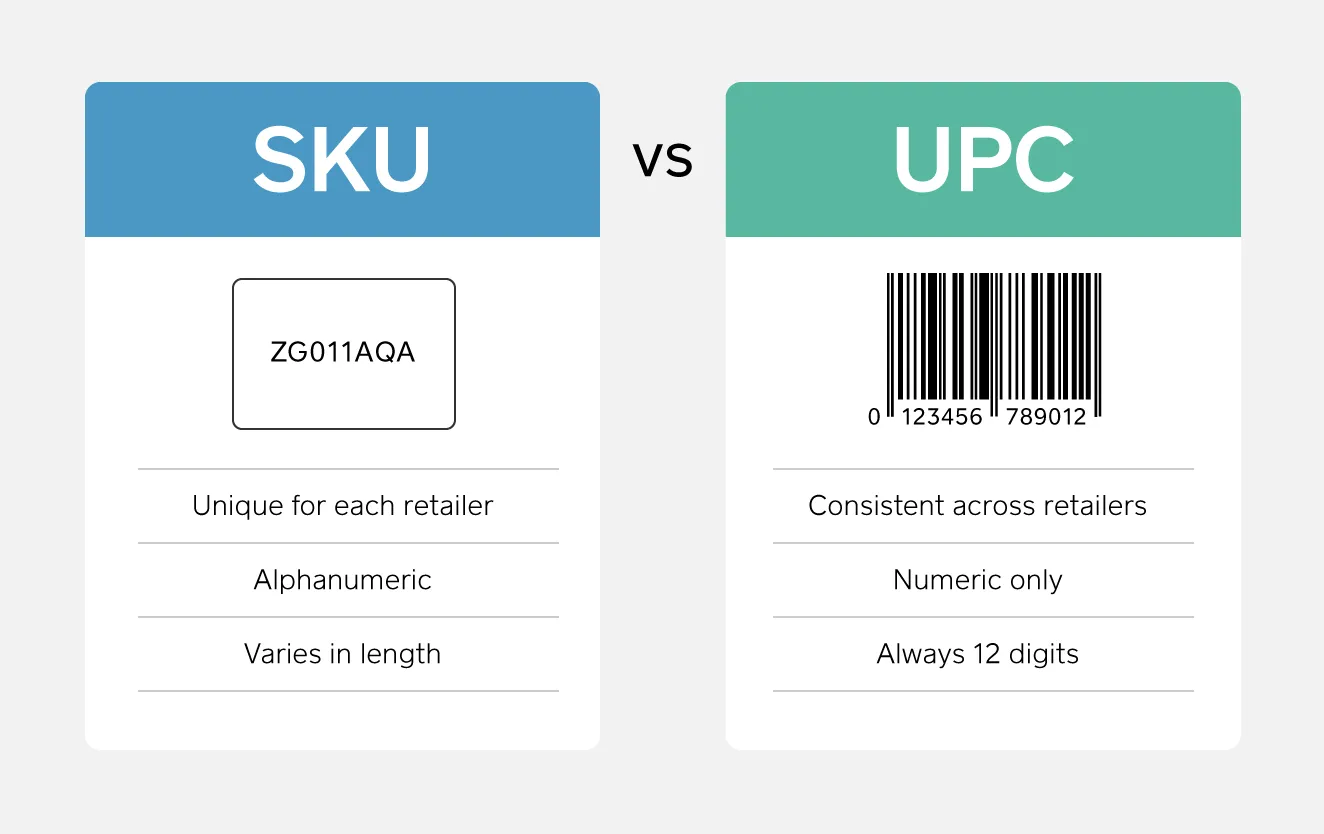Table of contents
In the world of retail acronyms, SKU is one you’ve likely heard countless times. Behind the scenes, SKUs do a lot of heavy lifting. They help retailers track stock levels, understand product variations, and make smarter purchasing decisions. If you’re looking to run a more efficient retail operation, here’s what SKUs are and how to use them effectively.
What is a SKU (stock keeping unit)?
A SKU (pronounced SKEW) stands for stock keeping unit and is a unique code that retailers create to track their products internally. It’s usually up to eight characters long and made from alphanumeric digits (a mix of letters and numbers). Every size, color, or style of an item gets its own SKU, making it easier to understand what is selling and what needs reordering.
How to use a SKU
SKUs help retailers keep products organized and understand how inventory is moving. With SKUs in place, you can quickly check whether an item is in stock, see which variations are performing well, and spot when it’s time to reorder. If you manage multiple locations or sell both in-store and online, SKUs also help you track where each item is and how fast it’s selling.
When you connect your SKUs to a POS or inventory system, they become even more powerful. You can automate reorders, prevent stockouts, reduce overstocking, and make smarter decisions about what to buy next based on real data.
Key characteristics of a SKU
Although businesses create their own SKU formats, most SKUs share common traits:
- Alphanumeric: SKUs typically combine letters and numbers to communicate product attributes such as type, brand, size, color, or collection.
- Human-readable structure: Many businesses start with category or brand letters, followed by numbers that identify variations. For example, TSH-BLK-08 could represent a black T-shirt, size 8.
- Short and scannable: SKUs are usually eight to twelve characters long so staff can read, type, or scan them easily.
- Unique to each product: No two products or variations should share the same SKU, even if they differ only slightly.
These characteristics make SKUs easy to interpret internally while supporting efficient tracking across systems.

SKUs vs. UPC codes
You may have heard SKU and UPC used interchangeably. They are similar but serve different purposes for in-store and online retailers.
A UPC, or universal product code, is a 12-digit numeric code that is attached to products wherever they are sold for external use. (It’s often referred to as a “UPC code,” awkwardly translating to “universal product code code.”)
So a product has the same UPC no matter where it’s sold, but different stores assign it different SKUs. SKUs are typically unique to a single retailer.
Then again, there are a lot of retailers that use UPCs as SKUs. But smaller shops (especially those that make their own products) may find it beneficial to create their own SKU system.
SKU management
If you’re going to use SKUs, their management is incredibly important. SKU management allows you to analyze the cost of carrying each product, so you can be sure that every piece of inventory meets the financial objectives of the business.
When done well, SKU management allows you to optimize your inventory levels and purchasing (and increase revenue). If done poorly, you’ll have high inventory holding costs and less available capital.
Best practices for creating SKUs:
- Each SKU should be unique for accurate inventory tracking. Avoid duplicate SKUs, even if it’s a variation of the same product.
- Do not use special characters or punctuation; only use numbers and letters from the alphabet.
- Keep it concise and logical. The first few letters should represent the highest category of importance depending on your business (for example, brand, make, then model).
- Always starting with a letter can help employees easily identify product categories.
- Maintain consistency in your SKU format across all products to streamline your inventory management. This consistency makes it easier for employees to understand and manage the SKUs.
- Periodically review and update your SKU system to ensure it remains relevant and efficient, especially as your product assortments evolve.
Common mistakes to avoid
Even well-intentioned SKU systems can become messy over time. Here are some of the most common mistakes to watch out for.
- Using overly complex codes: Long or cryptic SKUs slow down staff and increase errors. Keep your coding system short and readable.
- Reusing or duplicating SKUs: Once a SKU is assigned, it should never be reused, even if an item is discontinued. Duplicates create inventory inaccuracies that ripple across your system.
- Including special characters: Symbols like slashes, punctuation, or spaces may not be supported across all software tools and can break integrations.
- Failing to standardize a format: If every team member creates SKUs differently, your inventory becomes inconsistent. Choose a system and keep it uniform.
- Not updating the SKU system as the business grows: Product lines evolve, and your SKU structure should evolve with them. Periodically audit your SKUs to ensure they still fit your assortment.
Manual SKU management
You can manage SKUs manually or you can take an automated approach. If you go the manual route, you need to calculate two metrics,SKU ratio and the sales ratio, and then compare them.
Calculating SKU ratio
Start by looking at your product catalog and making a list of all your SKUs in a spreadsheet. For each SKU, note the price, how much it cost you, and the gross profit. (Subtract your cost from the price to determine your gross profit.)
Then create gross profit ranges in your spreadsheet (less than $20, $20–$29.99, etc.) and note how many SKUs fall in each range. Divide the number of SKUs in a range by the number of total SKUs (and multiply by 100) to get your SKU ratio for each range.
Calculating sales ratio
Using the same gross profit ranges, note the number of units sold (in a given period of time). Then divide the number of units sold in each gross profit range by the total units sold (and multiply by 100) to get the sales ratio for each range.
Examining your findings
In a spreadsheet, compare the SKU ratio and sales ratio of each gross profit range. (If you’re more of a visual person, you can also plot this information on a graph to see how your SKU ratio compares to your sales ratio.)
Your best-performing products fall in the gross profit range that has a sales ratio significantly higher than the SKU ratio. It means there is high demand for those products (and potential for generating more sales if you increase inventory or marketing).
Your gross profit range where the SKU ratio is higher than your sales ratio? Those are your worst performers. It means there is too much supply, and you should reduce inventory and marketing (or even stop selling the products).
Automated SKU management
If the manual process seemed a little tedious, that’s because it is. The easier route is to automate SKU management. Automating your SKU analysis saves time, reduces costs, and improves the accuracy of your data.
To automate the process, you want to leverage POS systems with integrated inventory management and other tools like barcoding. Using software to manage your inventory allows you to electronically track items in real time and automatically update inventory. In addition, built-in analytics help you create more efficient purchasing processes and more effective sales and marketing strategies.
The benefits of using SKUs to manage your business
SKUs provide insight into your business’s lifeblood — your inventory. It’s no surprise then that using SKUs properly can benefit businesses immensely when it comes to inventory management, customer experience, and even supply chain management.
Here are the top ways managing your SKUs, with the right technology, can improve operations and customer satisfaction.
Using SKUs for inventory management
SKUs are typically the easiest way to track an item’s availability across all locations, whether that be in person or online. Managing your SKUs with an intuitive point-of-sale (POS) system, like Square for Retail, gives businesses a line of sight into how products are moving across all locations.
When you know how your products are selling (or not selling), you can make informed decisions on when to run a discount, when to move inventory between store locations, and when to reorder product from suppliers. Investing in a POS system that automatically syncs inventory and sales data using SKUs will help your business take quick action based on real-time insights before ever running out of stock or running an unnecessary discount.
SKUs can even improve the customer experience
Using SKUs to track your stock will not only improve your inventory buying, but it can also help employees better serve customers. Using an intuitive and well-organized SKU management system enables staff to look up product information quickly and accurately to answer customer questions on the spot.
For example, if a customer is visiting a store in person and the size of sweater they’re interested in is not in stock at that particular location, you can help them order online or tell them to visit a nearby store where it is in stock. Providing customers with the information they need quickly can help build brand loyalists.
Forecasting sales and optimizing your supply chain with SKUs
Just like managing your SKUs well gives you a better shot at nailing inventory management, it can also improve your demand forecasting, or the ability to accurately predict what customers will want to buy and in what quantities throughout the year. Developing an accurate demand forecast will help avoid understocking and missing out on sales or overstocking and carrying unwanted inventory liability.
By using SKUs to get a clear picture of your available stock and sell-through patterns by product and product category, it becomes easier to predict sales patterns. When you’re able to forecast your sales demand accurately, it enables buyers to work with suppliers with enough advanced notice to secure the products required to maximize sales — typically at a better rate.
Master Your Supply Chain

Managing SKU numbers with Square for Retail
Square for Retail makes it easy to create, manage, and update SKU numbers across your entire catalog. You can manually add SKUs as you create items, or you can turn on automatic SKU generation to let Square handle it for you. Once enabled, Square will automatically assign SKUs to new items and variations, and you can also generate missing SKUs for items already in your catalog. Here’s how it works.
Enable automatic SKU generation
To get started, sign in to your Square Dashboard and go to Items & services > Items > Settings > Inventory, then toggle on Automatically generate SKUs. Once enabled, SKUs will populate automatically whenever you create a new item or add new item variations.
Generate missing SKUs in bulk
You can also fill in missing SKUs for your existing items. From your item library, open the Actions menu and select Generate SKUs. Square will create unique SKUs for any item variations that don’t already have one. If everything is already up to date, you’ll see a message confirming that no SKUs need to be generated.
Generate SKUs while printing labels
If you need barcode labels, Square can also generate SKUs during the label creation process. When you choose items to print labels for, Square will alert you if any variations are missing SKUs and give you the option to generate them automatically before printing or downloading your labels.
These tools ensure your catalog stays complete and consistent, even as your business grows. And if you don’t need advanced inventory tools, the free Square Point of Sale app still includes basic SKU support and inventory management features designed for smaller businesses. Read more about how Square compares with Shopify and other POS systems.
SKU FAQs
What is a stock keeping unit?
A stock keeping unit, or SKU, is an internal product identifier that helps businesses track inventory, categorize items, and monitor sales. Each SKU is unique to a product or product variation and is created by the retailer, not the manufacturer.
What is a SKU number?
A SKU or stock keeping unit number is a unique alphanumeric code a retailer assigns to each product or product variation to track stock levels and sales.
How are SKUs different from UPC codes or barcodes?
SKUs are internal codes created by a retailer for inventory management, while UPCs are universal codes assigned by manufacturers and used across all retailers. A product may have the same UPC everywhere but will have different SKUs at different stores.
How do I create SKUs for my products?
Start with a consistent naming structure that uses letters and numbers to represent product attributes like category, brand, color, or size. Keep SKUs short, readable, and unique. Avoid special characters and document the rules so your team applies them consistently.
What tools or software can help automate SKU management?
Inventory-enabled POS systems like Square for Retail can automatically generate SKUs, track product variations, sync inventory across channels, and automate replenishment alerts. Automation reduces manual errors and gives you real-time insight into product performance.
![]()













